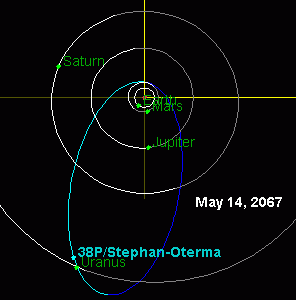 | |
| Discovery | |
|---|---|
| Discovered by | Coggia, Jerome E. |
| Discovery date | January 22, 1867 |
| Designations | |
| Alternative designations | P/1980 L2, P/1942 V1, P/1867 B1, 38P |
| Orbital characteristics | |
| Epoch | 1981-Apr-26 (JD 2444720.5) |
| Aphelion | 20.920 AU (near Uranus orbit) |
| Perihelion | 1.5744 AU (near Mars orbit) |
| Semi-major axis | 11.247 AU |
| Eccentricity | 0.86002 |
| Orbital period | 37.72 yr |
| Inclination | 17.981° |
| Last perihelion | November 10, 2018 December 5, 1980 |
| Next perihelion | 2056-Aug-28 |
38P/Stephan–Oterma (also known as Comet Stephan–Oterma) is a periodic comet with an orbital period of 38 years. It fits the classical definition of a Halley-type comet with (20 years < period < 200 years). It was discovered on 22.9 January 1867, by Jérôme Eugène Coggia at Marseilles Observatory, France. On 25.86 January Édouard Stephan confirmed it was a comet. It was recovered in 6 November 1942 by the Finnish astronomer Liisi Oterma.
38P/Stephan–Oterma last came to perihelion on November 10, 2018. It was recovered by Pan-STARRS on June 24, 2017 while 5.3 AU from the Sun. The next perihelion passage is August 28, 2056.
Orbit
It has perihelion near the orbit of Mars and has aphelion near the orbit of Uranus. Acting like a centaur-hybrid, between the years 1982 and 2067, this object will make close approaches to the giant planets Jupiter, Saturn, and Uranus.

References
- ^ "JPL Small-Body Database Browser: 38P/Stephan-Oterma" (last observation: 1981-04-04; arc: 114.18 years). Jet Propulsion Laboratory. Retrieved 2009-05-07.
- ^ MPC
- ^ Seiichi Yoshida (2004-07-31). "38P/Stephan-Oterma". Seiichi Yoshida's Comet Catalog. Retrieved 2011-10-23.
- "38P/Stephan-Oterma". cometography.com. Retrieved 5 February 2023.
- ^ "JPL Close-Approach Data: 38P/Stephan-Oterma" (last observation: 1981-04-04; arc: 114.18 years). Retrieved 2009-05-07.
External links
| Numbered comets | ||
|---|---|---|
| Previous 37P/Forbes |
38P/Stephan–Oterma | Next 39P/Oterma |
This comet-related article is a stub. You can help Misplaced Pages by expanding it. |

